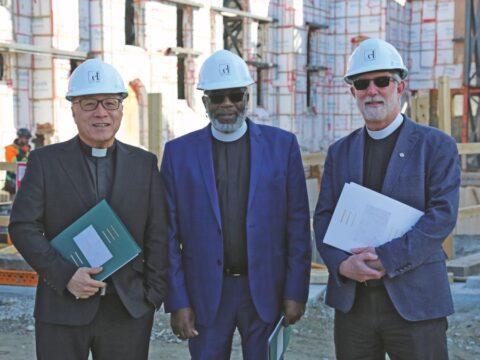A church task group currently crafting a proposal for a leaner United Church of Canada has encouraged feedback from various sectors of the church. The response the group has received from two Conferences suggests that its concept of more autonomy for congregations coupled with more centralized administration might be in for a rough ride.
The task group was created two years ago to carry out a sweeping review of the way The United Church of Canada works. Formally titled the Comprehensive Review Task Group, the nine-member panel released its second major discussion paper, Trust God: Trust the Body, last spring for consideration by the denomination’s 13 Conferences. In addition to ideas for financing, the paper details the roles and responsibilities of congregations (identified as “communities of faith” in the language of the report), the General Council (“the denomination”) and a vaguely defined “connectional space” between them.
You may unsubscribe from any of our newsletters at any time.
In a March response to the task group’s first discussion paper, Fishing on the Other Side, British Columbia Conference’s Executive seemed to anticipate the second paper and spoke clearly against the centralization that would come with a church governed by two courts instead of the current four (pastoral charges, Presbyteries, Conferences and the General Council). In June, Maritime Conference’s Executive formally rejected the two-court concept and put forth an alternative model of its own.
Coming from the church’s wealthiest Conference (B.C.) and its largest one (Maritime), the challenges show that the two-court concept, eliminating both Conferences and Presbyteries, may need alteration. As the task group headed into a summer hiatus, chair Rev. Cathy Hamilton of Deux Montagnes, Que., said nothing is set in stone.
“We want to be sure people understand what was written and the concept is clear, but we’re not in a position of defending anything,” she says. “I think we’re trying a process that hasn’t been used a lot in the United Church.”
Usually, task groups form proposals, gain the approval of the General Council Executive and then head to General Council’s triennial meeting for approval, improvement or defeat. Instead, says Hamilton, the Comprehensive Review group is releasing concepts and providing opportunities for feedback online and at Presbytery and Conference meetings, before releasing a recommended proposal at the fall meeting of the Executive of General Council next month.
Data from Presbytery and Conference surveys, to be released this fall, will likely show whether Presbyteries and Conferences are warm or cool to the task group’s current concept. Five Conferences did not hold annual general meetings, but all were able to respond in some fashion.
“As you are trying to create a structure that reduces costs, liberates energy for mission and ministry, reduces duplication and at the same time honours the sense of United Church ethos, there are quite a variety of different ways you can do that,” says Hamilton. “We are certainly not back to square one. We now have huge numbers of people who are engaged in this process, who want to be part of how this is going to happen.”
Concerns like those originating in B.C. and Maritime Conferences won’t likely be addressed by simply tinkering with the two-court concept that has been circulated so far.
Rev. Doug Goodwin, executive secretary of B.C. Conference, emphasizes that the Conference did not put forth a specific alternative to the two-court model. But it did recognize a “mood for change,” coupled with little consensus on a “national top-down plan.” The Conference prefers an approach where “groups or organizations reshape themselves,” similar to what’s happened in Toronto Conference, where enlarged Presbyteries were given Conference-funded staff and enhanced powers.
B.C. Conference Executive told the national task group it should focus on “empowering congregational life” rather than revising the four-court system. “There needs to be at least one intermediary court between the local and the national bodies,” the B.C. response said. It also spoke against the centralization of power and authority in the denominational sphere of a two-court concept.
As for immediate structural change, the B.C. Executive suggested the church “move forward organically” instead, with Conferences and Presbyteries sharing power between them depending on local needs.
Maritime Conference’s “alternate model of governance” envisions a smaller General Council Office and slightly larger regional bodies with more resources to support pastoral relationships.
“We believe that communities of faith are best supported by regional bodies that are geographically close to them,” says the Conference’s 12-page report, complete with graphs, a “theological rationale” and “doctrinal wisdom for church change.”
It rejects the task group’s idea of creating both a college of ministers and an association of ministers to oversee clergy matters. “We need to be disciplined by the people we have fellowship with and eat with, as a Body of Christ rather than a profession,” says Rev. Jane Johnson, a minister in rural New Brunswick and a member of the Maritime Conference response group, named at the Conference’s annual meeting last spring.
The response group proposes a three-court church with strong regional bodies, much like the current Conferences, that would administer ministry personnel.
“Conferences relating to each other, collaborating and connecting would create an inspiring powerful democratized model of church for these new times,” says the Maritime report. “Collectively they would provide direction to a much smaller General Council body.”
For church people far from General Council’s Toronto offices, the lack of nearby regional staff that could come with a two-court structure is unappealing. “There’s enough of a sense of isolation already,” says Rev. Wayne Blackwood of Salmon Cove, N.L., past president of Newfoundland and Labrador Conference. “For me, it’s almost like we’re being cut adrift.”
The Comprehensive Review Task Group’s second report, Trust God; Trust the Body, addresses financial issues linked to declining membership, lower givings to the denomination’s main fundraising campaign and continuing General Council budget woes. Despite their qualms about structural changes, both B.C. and Maritime Conferences were positive about the funding model. Congregations, however, may not share their enthusiasm.
The General Council has been running an operating deficit for several years and will need to find millions of dollars in savings down the road. Denominational administration and governance work is largely funded through the Mission and Service Fund, which faces a continuing decline in donations. The challenge for the task group is to make governance and administration less costly while freeing up more money for mission and ministry.
The task group’s concept would see congregations pay a tax-like assessment of four percent of their revenue (minus bequests, capital projects and M&S givings) to fund administration and governance. With $400 million in congregational income in 2012, that would translate into about $15 million after deductions — roughly $3 million less than the current funding (from assessments and General Council budgets) for the work of governance and leadership in Presbyteries, Conferences and the General Council.
The M&S Fund would continue to finance “ministry and mission activities” but would be “separated from governance and denominational administration,” says the discussion paper, making it a “strong destination for donations while increasing transparency.” This assumes, of course, that congregations — many of whom face serious financial pressures of their own — can sustain givings to M&S while paying an additional $4.7 million in assessments.
Moreover, the upheaval of wholesale structural change may be seen at the grassroots as a high price to pay for a sustainable General Council budget.
“You can shift Conference and Presbytery and General Council around every way you want,” says Rev. Shannon McCarthy, executive secretary of Manitoba and Northwestern Ontario Conference. “But at the end of the day, 90 percent of it is not going to affect a congregation’s life.”
A recent online discussion centred on whether a “Plan B” restructuring proposal might emerge. Rev. Richard Bott of Maple Ridge, B.C., said he expected to see several presented to General Council, together with the task group’s own proposal.
“General Council will work to find the best of the proposals, and pull something out of them,” he wrote. “And, in the end, whatever the structure, there will be congregations that disappear and congregations that grow. . . . We will continue to help people to enter into and deepen their relationship with God, in Christ, in our own special ways. And life — and ministry — will go on.”
***
This story first appeared in The United Church Observer’s October 2014 issue with the title “Streamlining scheme hits a bump.”













